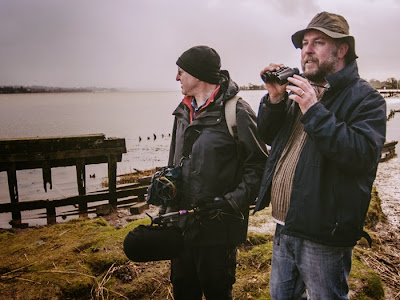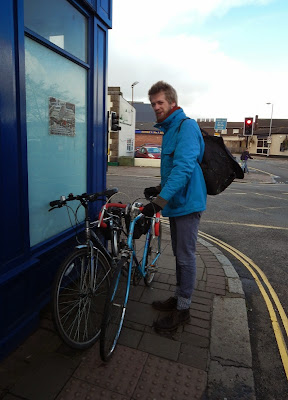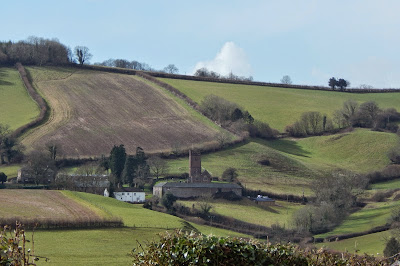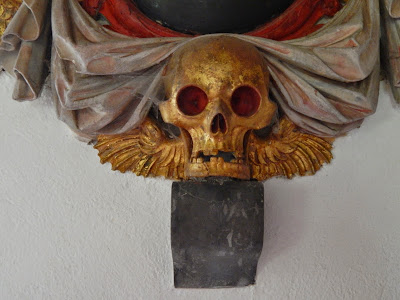Sound recordist and musician Chris Watson was in conversation at the Royal Albert Memorial Museum with RSPB communications officer for the South West Tony Whitehead last night. Perhaps the differentiation between the two endeavours is a false one, however. In response to a question about the influence of his natural sound recordings on his music, Watson replied that he made no distinction between them. He has spoken before about the microphone being his instrument, and a highly versatile and adaptable one at that. Musicians and composers have long attempted to mimic or summon up the sounds of nature, from the shrill marsh bird cries of Japanese shakuhachi players through Beethoven’s programmatic traversal of the countryside in the Pastoral Symphony to Messiaen’s transliteration of avian song .Perhaps electronic musicians have come closest to evoking the complex and profoundly inhuman soundworld of melodic birdsong clusters, the seethe and chitter of insects and the compression and echoing boom of subaquatic depths. Watson mentioned his own indebtedness to Pierre Schaeffer and his musique concrete descendants. He fondly recalled his own early childhood recordings with a portable reel to reel tape machine given as a present by prescient parents. He fixed a microphone to the seed-strewn bird table in the garden, set the reels in motion and retreated inside to see what hungry visitors he might sonically capture with his new magnetic magic box. It was one of those moments, epiphanic in recollection, when a lifetime of vocational creativity is seeded. Bird seeded in this instance.
Watson, a son of the People’s Republic of Sheffield now resident in Newcastle, spent a decade of discovery and experiment in Cabaret Voltaire with Stephen Mallinder and Richard Kirk from 1971-1981, pre- to post-punk, only recording in the latter years of that fertile period. Working in his attic, a space which was half artist’s garrett, half mad scientist’s lab, the trio played freely with sound, seldom producing anything resembling conventional pop or rock. If they did, it was by accident and would be swiftly discarded. Watson built his own equipment, exhibiting an inventiveness and ingenuity, as well as a readiness to make lateral use of the materials to hand, which would stand him in good stead for the challenges of his future career. He laboured over cut-ups and tape loops, guided his oscillator through undulating frequencies and transformed his organ playing through heavy processing until it sounded less like its instrumental self, more like a generator of sound swarms. He was delighted with the development of synthesisers, and the way that ‘non-musicians’ like Brian Eno used them, and bought an EMS AKS in the latter half of the 70s. It was this which he used on the debut Cabaret Voltaire LP Mix-UP, released in 1979. Watson left the group in 1981, shortly after a visit to the Top of the Pops studios to witness another band performing. Horrified at a vision of what might be, he left to pursue other interests. He did briefly continue his tape and concrete explorations with The Hafler Trio, however, a proliferating project initiated and masterminded by Andrew M.McKenzie and only occasionally and incidentally attaining the status of an actual trio.
Watson joined Tyne Tees Television as a sound recordist and then returned to that epiphanic childhood moment and worked for the RSPB, recording the sounds of birds and their environments. As he pointed out in his discussion with Tony Whitehead, the production of RSPB films was an invaluable apprenticeship for him and many others who went on to make wildlife films for the BBC. Watson himself is now a highly esteemed wildlife recordist, and has worked on innumerable programmes, including the all-important Attenbouroughs. He mentioned what a privilege it was to work with Sir David, describing him as ‘the perfect travelling companion’. These programmes have given him the opportunity to immerse himself in a hugely diverse range of environments and build up a cumulative sound picture which effectively encompasses much of the globe.
The detail and texture of sound are very important to him, as is the way in which it is heard. He is mildly disdainful of the compression and diminution of sound transmitted through TV speakers or stereo headphones. He prefers installations in which surround sound set-ups can come nearer to approximating natural sound as it is perceived in situ. The upstairs gallery to the rear of the museum allowed for a wide speaker spectrum, with a bass cone in the middle emitting low frequency rumble. This was ideal for the subsonic sounds of elephants, a harrumph whose vibrations affected the diaphragm as much as the eardrum. Watson pointed out that the fundamental, the root note, was below the range of human perception, so what we were hearing were the harmonics arrayed above it. Close-up recordings of a cheetah purr were similarly deep and resonant, solid waves of physically palpable sound which weren’t so far off from Sunn ((o)) drone power chords. Watson spoke of the musicality of this sound, and of others. There is something very Cageian about his refusal to demarcate between music and the sounds of the natural world. Close listening reveals the musicality inherent in a whole spectrum of living sounds. He also emphasised the intelligence of various animals, exhibiting a respect for life and a scepticism about the primacy of humanity and its assumed position at the head of the great chain of being. Orcas and Vultures seemed to particularly draw his admiration.
We were treated to a dizzying panoply of natural sounds, from the tiniest shrimps to the mightiest whales. The blue whale recording was not his own, he confessed. It remains his holy grail, a more benign Ahab quest to capture an awe-inspiring call capable of sounding out hundreds of miles of subaquatic space. The whale call truly tested the capacity of the speakers, its submarine frequencies a bone-shuddering groan until pitch-shifted upwards into a more audible range. It still made the chants of Tibetan monks sound like soprano squeaks, though. Watson argues, naturally enough, for the sound picture of a natural environment being as important as the visual aspect. It can be more stimulating to the imagination, and create more of a sense of being vitally present. Sound recording can almost be akin to magic in the way that it transports us to worlds which would otherwise be wholly inaccessible to our senses. We shrink to earwig on insect kingdoms and grow invisible to listen to animals which would shy from the merest hint of human presence. One of Watson’s most remarkable recordings was made by attaching contact mics. to the inside of a zebra’s rib-cage, killed the previous night and already lion-chewed and stripped of its prime cuts. Watson had rehearsed such a set-up on a post-Christmas turkey carcass, rejected by his seasonally satiated family. He recorded the metallic skraw of starlings which soon descended to devour the flesh and pick the bird’s bones clean. The vultures had spotted the zebra’s corpse from way up high and surrounded it, checking out the locale. Watson observed them and noted that they were highly aware that there was something unusual about this piece of carrion, even though he had done his best to conceal his wires and mics. Again, he emphasised the wily intelligence of these wary creatures. It took them some five hours before they eventually set to, beginning their thorough clean-up operation. By this time the unfortunate zebra was engulfed in a dark nebula of flies. The recording floats on the swarming drone of their incessant zzzzzzhhhhhh. Watson suggested that vultures were exactly as you’d expect them to sound – like scimitar slashes of guitar feedback. He was right. It was a remarkable sound, intoxicating yet slightly nauseating at the same time. You could almost sense the overpowering stench of death in your nostrils, an understandable synaesthetic response. Watson took this recording on one of his school visits once, using it to begin his presentation. ‘This is the last sound you would hear before you died, if you were a zebra’, he told the assembly of rapt children. He wasn’t invited back, he ruefully noted. But the kids loved it.
Chris Watson and Tony Whitehead on the Exe EstuaryOther sounds were called for by Tony Whitehead and members of the audience, Watson suggesting that it was becoming like a request show. The brief grunt of a cod even received an encore. It sounded like the swinging doors in Jacques Tati’s Monsieur Hulot’s Holiday. There was a haddock chorus from a fjord near Bergen, the ambient hum of midshipman fish, the sonic attack of a pistol shrimp, made with its oversized claw, and the grate and scrape of grazing limpets, recorded at high tide in Batten Bay, Plymouth. The tuned percussion of a capercaillie recorded in Scotland apparently attracted the attentions of Bjork, who was so entranced by its inherent musical qualities that she got in touch with Watson and asked if she could use it in a piece of her own. She has since attended one of Watson’s sound recording workshops in Iceland. He joked that she was a useful contact given her facility with a four wheel drive in the remoter wilds of her native country.
Watson and Whitehead both have an abiding concern with the issue of noise pollution in the modern world and the psychological impact this has on people’s lives. Watson noted that the recordings of starlings he had made 30 years ago, in which they imitated the sounds they heard around them, would be wholly different today. It was a sound picture which acted as a memorial to a world whose sonic character has changed rapidly over the intervening period. He mentioned the activism of Gordon Hempton in America, an ‘acoustic ecologist’ who is attempting to create a notional sanctuary comprising one square inch of silence in Olympic National Park, Washington State. Watson played his recordings of Orcas in the waters beneath the North Polar ice, emphasising the extent to which they lived in a world of sound; practically in terms of their echo location clicks and socially in terms of their keening calls and cries. He then played a recording in which the combine grind of the approaching icebreaking ship Odin could be heard loudly approaching from some 100 miles in the distance distance. Such noise pollution must have a devastating effect on such aurally sensitive creatures, he pointed out. It has been suggested that loud sonar beacons placed in the oceans to guide submarines have resulted in the mass beachings of dolphins and whales, driven out of their usual territories by this invasive noise. Watson talked of the almost transcendental experience of standing outside Scott’s hut in the Antarctic and reflecting upon the fact that in this quietest of spots he was experiencing a soundworld unchanged since the ill-fated expedition some century before. It was an experience unthinkable in most other regions of the world.
Watson is concerned with the loss of the ability to really listen. He is disdainful of the blanket use of music in wildlife documentaries. Sound recordings would be much more involving for the viewer, who would then also become a more active listener. I wholeheartedly agree on this point. The use of sweeping string themes, combined with swooping helicopter or crane shots, amounts to a bullying emotional manipulation, akin to being grasped by the lapels, shaken up a bit and yelled at to ‘feel some awe and shed a tear at the spectacle of it all, goddamn you’. Music, humorous or sentimental, also encourages a relentless anthropomorphism which detracts from a true appreciation of the otherness of non-human species. His own observance of quietude included conducting the interview in his socks. As he explained in an interview in The Wire some years back, in which an interviewer made the same observation, he doesn’t ‘like clomping around’. Whitehead shares his interest in quietude. Quietness not as an absence of sound, as both were quick to point out. That would be a highly, well, disquieting experience, an indicator of the absence of life. But quietness in the sense of an environment in which the true spatial depth and density of sound can be appreciated, the individual elements differentiated and their variation over time appreciated. Whitehead has invited sound artists from around the world to send their recordings of quiet environments to him, and he has released some of them on his Very Quiet Records label. They range from the island of Jogashima in Japan to Jean-Baptiste Masson’s recordings of the South African bush at midnight, Kalmara Xinsekt’s night sounds in the Amazonian rainforests to Joe Stevens’ birping of spawning Dorset frogs. Together, they form an invaluable soundpicture of the quietude still to be found in the world.
Chris Watson was a hugely personable speaker, conveying his enthusiasm for sound with quiet authority. His memories and sound-illustrated anecdotes were ably facilitated by the informal and also highly informed Tony Whitehead. A marvellous evening, in the true sense of the word. Chris was here in conjunction with the sound installation currently running in the museum’s back entrance area. The sound picture here shifts from the coastal ebb and flow of the tide through the kelp beds of Maer Rocks, Exmouth, the song of cirl buntings, skylarks and greenfinches in the RSPB managed farmland atop Labrador Bay near Shaldon, Dartford warblers and tree pipits on the Aylesbeare pebblebeds and finally to the oak woodlands of Yarner Wood, dense with the calls of song thrushes, cuckoos, willow warblers, wrens, tawny owls and carrion crows. It’s a fine piece, a sonic journey which takes us seamlessly through four different environments. A little sound bleeding from the geology section below introduces a bit of ambient drone from time to time, but it’s not overly intrusive. Some might argue that it actually adds a further dimension to the experience, although I suspect Watson wouldn’t be amongst them. Natural sound is rich with its own musicality, he would point out, and needs no distracting attempts at enhancement. The sound picture will change with the seasons, offering us pictures for ears from 7 more sites, presumably including those deadly pistol shrimps from Plymouth. CRACK. So go along to the museum, stand by the balcony at the top of the stairs, close your eyes and conjure up your own pictures in sound. In this light filled interior atrium, you will soon be lost in your own interior world.










.jpg)










_01.JPG)









.jpg)















